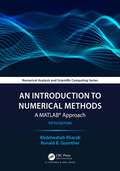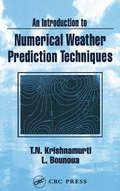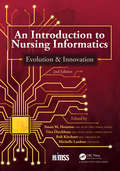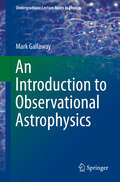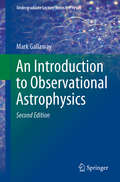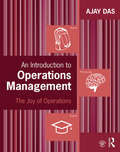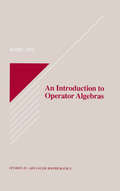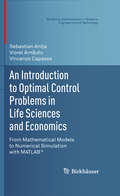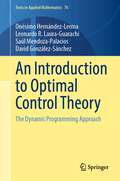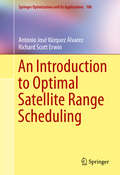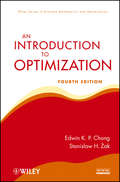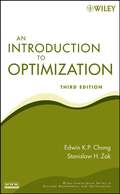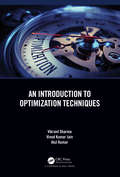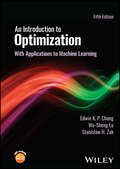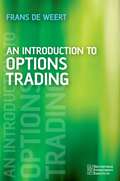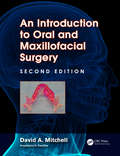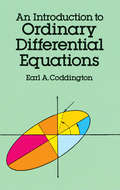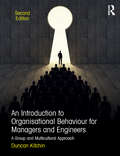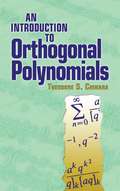- Table View
- List View
An Introduction to Numerical Methods: A MATLAB® Approach (Chapman & Hall/CRC Numerical Analysis and Scientific Computing Series)
by Abdelwahab Kharab Ronald GuentherAn Introduction to Numerical Methods: A MATLAB® Approach, Fifth Edition continues to offer readers an accessible and practical introduction to numerical analysis. It presents a wide range of useful and important algorithms for scientific and engineering applications, using MATLAB to illustrate each numerical method with full details of the computed results so that the main steps are easily visualized and interpreted. This edition also includes new chapters on Approximation of Continuous Functions and Dealing with Large Sets of Data. Features: Covers the most common numerical methods encountered in science and engineering Illustrates the methods using MATLAB Ideal as an undergraduate textbook for numerical analysis Presents numerous examples and exercises, with selected answers provided at the back of the book Accompanied by downloadable MATLAB code hosted at https/www.routledge.com/ 9781032406824
An Introduction to Numerical Weather Prediction Techniques
by T. N. Krishnamurti Lahouari BounouaAn Introduction to Numerical Weather Prediction Techniques is unique in the meteorological field as it presents for the first time theories and software of complex dynamical and physical processes required for numerical modeling. It was first prepared as a manual for the training of the World Meteorological Organization's programs at a similar level. This new book updates these exercises and also includes the latest data sets. This book covers important aspects of numerical weather prediction techniques required at an introductory level. These techniques, ranging from simple one-dimensional space derivative to complex numerical models, are first described in theory and for most cases supported by fully tested computational software. The text discusses the fundamental physical parameterizations needed in numerical weather models, such as cumulus convection, radiative transfers, and surface energy fluxes calculations. The book gives the user all the necessary elements to build a numerical model. An Introduction to Numerical Weather Prediction Techniques is rich in illustrations, especially tables showing outputs from each individual algorithm presented. Selected figures using actual meteorological data are also used.This book is primarily intended for senior-level undergraduates and first-year graduate students in meteorology. It is also excellent for individual scientists who wish to use the book for self-study. Scientists dealing with geophysical data analysis or predictive models will find this book filled with useful techniques and data-processing algorithms.
An Introduction to Nursing Informatics, Evolution, and Innovation, 2nd Edition: Evolution and Innovation (HIMSS Book Series)
by Susan M. Houston Tina Dieckhaus Bob Kircher Michelle LardnerNursing informatics (NI) is the specialty that integrates nursing science with information management and analytical sciences to identify, define, manage, and communicate data, information, knowledge, and wisdom in nursing practice. Nursing Informatics supports nurses, consumers, patients, the interprofessional healthcare team, and other stakeholders in a wide variety of roles and settings to achieve desired outcomes. This is accomplished through the use of information structures, information processes, and information technology. An Introduction to Nursing Informatics, Evolution and Innovation, 2nd Edition is the ideal gateway to all the professional possibilities this continuously evolving discipline has to offer. Describing the evolution of nursing informatics from its origins to current practice in today’s complex, diverse healthcare environment, this book offers the next generation of nurse informaticists an understanding of the discipline, best practices, and its scope of influence in healthcare. The book also explores Nursing Informatics as it is evolving into the future, including technology creation and implementation and the development of influential policies and best practices. Special features include descriptions of the ‘a day in the life’ from informatics nurses in multiple roles and fields of influence, including academia, research, clinical settings, the executive suite, consulting, and government, as well as an Appendix featuring case profiles. This new edition updates the content to better align with the current state of nursing informatics and expand on additional roles. New to this edition is a chapter providing tips and advice for those trying to find their first nursing informatics job or are changing their careers. Another new chapter covers healthcare analytics and how it fits into the nursing informatics role. An Introduction to Nursing Informatics, Evolution and Innovation, 2nd Edition is the ideal resource for nursing students and as a reference guide and pint of inspiration for nurses currently in the field.
An Introduction to Object Recognition: Selected Algorithms for a Wide Variety of Applications (Advances in Computer Vision and Pattern Recognition)
by Marco Alexander TreiberRapid development of computer hardware has enabled usage of automatic object recognition in an increasing number of applications, ranging from industrial image processing to medical applications, as well as tasks triggered by the widespread use of the internet. Each area of application has its specific requirements, and consequently these cannot all be tackled appropriately by a single, general-purpose algorithm. This easy-to-read text/reference provides a comprehensive introduction to the field of object recognition (OR). The book presents an overview of the diverse applications for OR and highlights important algorithm classes, presenting representative example algorithms for each class. The presentation of each algorithm describes the basic algorithm flow in detail, complete with graphical illustrations. Pseudocode implementations are also included for many of the methods, and definitions are supplied for terms which may be unfamiliar to the novice reader. Supporting a clear and intuitive tutorial style, the usage of mathematics is kept to a minimum. Topics and features: presents example algorithms covering global approaches, transformation-search-based methods, geometrical model driven methods, 3D object recognition schemes, flexible contour fitting algorithms, and descriptor-based methods; explores each method in its entirety, rather than focusing on individual steps in isolation, with a detailed description of the flow of each algorithm, including graphical illustrations; explains the important concepts at length in a simple-to-understand style, with a minimum usage of mathematics; discusses a broad spectrum of applications, including some examples from commercial products; contains appendices discussing topics related to OR and widely used in the algorithms, (but not at the core of the methods described in the chapters). Practitioners of industrial image processing will find this simple introduction and overview to OR a valuable reference, as will graduate students in computer vision courses. Marco Treiber is a software developer at Siemens Electronics Assembly Systems, Munich, Germany, where he is Technical Lead in Image Processing for the Vision System of SiPlace placement machines, used in SMT assembly.
An Introduction to Observational Astrophysics (Undergraduate Lecture Notes in Physics)
by Mark GallawayObservational Astrophysics follows the general outline of an astrophysics undergraduate curriculum targeting practical observing information to what will be covered at the university level. This includes the basics of optics and coordinate systems to the technical details of CCD imaging, photometry, spectography and radio astronomy. General enough to be used by students at a variety of institutions and advanced enough to be far more useful than observing guides targeted at amateurs, the author provides a comprehensive and up-to-date treatment of observational astrophysics at undergraduate level to be used with a university's teaching telescope. The practical approach takes the reader from basic first year techniques to those required for a final year project. Using this textbook as a resource, students can easily become conversant in the practical aspects of astrophysics in the field as opposed to the classroom.
An Introduction to Observational Astrophysics (Undergraduate Lecture Notes in Physics)
by Mark GallawayThe observational component of astronomy is an exciting and vital part of any astrophysics degree. With the advent of low-cost astronomical cameras and remote and robotic operation, more students than ever have the opportunity to observe and perform observatory research. This updated and fully corrected textbook provides a comprehensive overview of practical observing techniques for undergraduate astrophysics courses. The chapters introduce students to the basics of the field before delving into telescope types, the nature and operation of the astronomical camera, imaging techniques and reduction, photometry and spectrography, and solar and radio observations.The second edition covers the latest research on calibrating the telescope-camera-observatory system. It contains revised information on all available astronomy equipment, including filters, webcams, sensors, and telescope designs. Also included is an entirely new chapter on exoplanet transit measurements. The textbook’s practical approach will guide readers from basic first-year techniques to those required for a final-year project.
An Introduction to Ocean Remote Sensing
by Seelye MartinExamining the use of satellite data in the retrieval of oceanic physical and biological properties, this study presents examples of the kinds of data that can be acquired and recounts their oceanographic application. It also describes the national and international programs in satellite oceanography of the past two decades, and reviews current and future programs up to 2019. The textbook, designed for graduate and senior undergraduate courses in satellite oceanography, will prepare students and interested scientists to use satellite data in oceanographic research.
An Introduction to Operations Management: The Joy of Operations
by Ajay DasAn Introduction to Operations Management: The Joy of Operations covers the core topics of operations management, including product and service design, processes, capacity planning, forecasting, inventory, quality, supply chain management, and project management. Das provides a clear, connected, and current view of operations management and how it relates to a firm’s strategic goals. Students will benefit from the real-world scenarios that foster an understanding of operations management tasks. Without relying heavily on statistics and mathematical derivations, the book offers applied models and a simple, predictable chapter format to make it easy to navigate. Students of introductory operations management courses will love this practical textbook. A companion website features an instructor’s manual with test questions, as well as additional exercises and examples for in-class use.
An Introduction to Operator Algebras (Studies in Advanced Mathematics #9)
by Kehe ZhuAn Introduction to Operator Algebras is a concise text/reference that focuses on the fundamental results in operator algebras. Results discussed include Gelfand's representation of commutative C*-algebras, the GNS construction, the spectral theorem, polar decomposition, von Neumann's double commutant theorem, Kaplansky's density theorem, the (continuous, Borel, and L8) functional calculus for normal operators, and type decomposition for von Neumann algebras. Exercises are provided after each chapter.
An Introduction to Optimal Control Problems in Life Sciences and Economics: From Mathematical Models to Numerical Simulation with MATLAB® (Modeling and Simulation in Science, Engineering and Technology)
by Viorel Arnăutu Sebastian Aniţa Vincenzo CapassoCombining control theory and modeling, this textbook introduces and builds on methods for simulating and tackling concrete problems in a variety of applied sciences. Emphasizing "learning by doing," the authors focus on examples and applications to real-world problems. An elementary presentation of advanced concepts, proofs to introduce new ideas, and carefully presented MATLAB® programs help foster an understanding of the basics, but also lead the way to new, independent research. With minimal prerequisites and exercises in each chapter, this work serves as an excellent textbook and reference for graduate and advanced undergraduate students, researchers, and practitioners in mathematics, physics, engineering, computer science, as well as biology, biotechnology, economics, and finance.
An Introduction to Optimal Control Theory: The Dynamic Programming Approach (Texts in Applied Mathematics #76)
by David González-Sánchez Onésimo Hernández-Lerma Saul Mendoza-Palacios Leonardo R. Laura-GuarachiThis book introduces optimal control problems for large families of deterministic and stochastic systems with discrete or continuous time parameter. These families include most of the systems studied in many disciplines, including Economics, Engineering, Operations Research, and Management Science, among many others. The main objective is to give a concise, systematic, and reasonably self contained presentation of some key topics in optimal control theory. To this end, most of the analyses are based on the dynamic programming (DP) technique. This technique is applicable to almost all control problems that appear in theory and applications. They include, for instance, finite and infinite horizon control problems in which the underlying dynamic system follows either a deterministic or stochastic difference or differential equation. In the infinite horizon case, it also uses DP to study undiscounted problems, such as the ergodic or long-run average cost. After a general introduction to control problems, the book covers the topic dividing into four parts with different dynamical systems: control of discrete-time deterministic systems, discrete-time stochastic systems, ordinary differential equations, and finally a general continuous-time MCP with applications for stochastic differential equations. The first and second part should be accessible to undergraduate students with some knowledge of elementary calculus, linear algebra, and some concepts from probability theory (random variables, expectations, and so forth). Whereas the third and fourth part would be appropriate for advanced undergraduates or graduate students who have a working knowledge of mathematical analysis (derivatives, integrals, ...) and stochastic processes.
An Introduction to Optimal Control of FBSDE with Incomplete Information (SpringerBriefs in Mathematics)
by Guangchen Wang Zhen Wu Jie XiongThis book focuses on maximum principle and verification theorem for incomplete information forward-backward stochastic differential equations (FBSDEs) and their applications in linear-quadratic optimal controls and mathematical finance. Lots of interesting phenomena arising from the area of mathematical finance can be described by FBSDEs. Optimal control problems of FBSDEs are theoretically important and practically relevant. A standard assumption in the literature is that the stochastic noises in the model are completely observed. However, this is rarely the case in real world situations. The optimal control problems under complete information are studied extensively. Nevertheless, very little is known about these problems when the information is not complete. The aim of this book is to fill this gap. This book is written in a style suitable for graduate students and researchers in mathematics and engineering with basic knowledge of stochastic process, optimal control and mathematical finance.
An Introduction to Optimal Satellite Range Scheduling (Springer Optimization and Its Applications #106)
by Antonio José Vázquez Álvarez Richard Scott ErwinThe satellite range scheduling (SRS) problem, an important operations research problem in the aerospace industry consisting of allocating tasks among satellites and Earth-bound objects, is examined in this book. SRS principles and solutions are applicable to many areas, including: Satellite communications, where tasks are communication intervals between sets of satellites and ground stations Earth observation, where tasks are observations of spots on the Earth by satellites Sensor scheduling, where tasks are observations of satellites by sensors on the Earth. This self-contained monograph begins with a structured compendium of the problem and moves on to explain the optimal approach to the solution, which includes aspects from graph theory, set theory, game theory and belief networks. This book is accessible to students, professionals and researchers in a variety of fields, including: operations research, optimization, scheduling theory, dynamic programming and game theory. Taking account of the distributed, stochastic and dynamic variants of the problem, this book presents the optimal solution to the fixed interval SRS problem and how to migrate results into more complex cases. Reference algorithms and traditional algorithms for solving the scheduling problems are provided and compared with examples and simulations in practical scenarios.
An Introduction to Optimization
by Edwin K. Chong Stanislaw H. ZakPraise from the Second Edition"...an excellent introduction to optimization theory..." (Journal of Mathematical Psychology, 2002)"A textbook for a one-semester course on optimization theory and methods at the senior undergraduate or beginning graduate level." (SciTech Book News, Vol. 26, No. 2, June 2002)Explore the latest applications of optimization theory and methodsOptimization is central to any problem involving decision making in many disciplines, such as engineering, mathematics, statistics, economics, and computer science. Now, more than ever, it is increasingly vital to have a firm grasp of the topic due to the rapid progress in computer technology, including the development and availability of user-friendly software, high-speed and parallel processors, and networks. Fully updated to reflect modern developments in the field, An Introduction to Optimization, Third Edition fills the need for an accessible, yet rigorous, introduction to optimization theory and methods.The book begins with a review of basic definitions and notations and also provides the related fundamental background of linear algebra, geometry, and calculus. With this foundation, the authors explore the essential topics of unconstrained optimization problems, linear programming problems, and nonlinear constrained optimization. An optimization perspective on global search methods is featured and includes discussions on genetic algorithms, particle swarm optimization, and the simulated annealing algorithm. In addition, the book includes an elementary introduction to artificial neural networks, convex optimization, and multi-objective optimization, all of which are of tremendous interest to students, researchers, and practitioners.Additional features of the Third Edition include:New discussions of semidefinite programming and Lagrangian algorithmsA new chapter on global search methodsA new chapter on multipleobjective optimizationNew and modified examples and exercises in each chapter as well as an updated bibliography containing new referencesAn updated Instructor's Manual with fully worked-out solutions to the exercisesNumerous diagrams and figures found throughout the text complement the written presentation of key concepts, and each chapter is followed by MATLAB exercises and drill problems that reinforce the discussed theory and algorithms. With innovative coverage and a straightforward approach, An Introduction to Optimization, Third Edition is an excellent book for courses in optimization theory and methods at the upper-undergraduate and graduate levels. It also serves as a useful, self-contained reference for researchers and professionals in a wide array of fields.
An Introduction to Optimization (Wiley Series in Discrete Mathematics and Optimization #72)
by Edwin K. Chong Stanislaw H. ZakPraise from the Second Edition "...an excellent introduction to optimization theory..." (Journal of Mathematical Psychology, 2002) "A textbook for a one-semester course on optimization theory and methods at the senior undergraduate or beginning graduate level." (SciTech Book News, Vol. 26, No. 2, June 2002) Explore the latest applications of optimization theory and methods Optimization is central to any problem involving decision making in many disciplines, such as engineering, mathematics, statistics, economics, and computer science. Now, more than ever, it is increasingly vital to have a firm grasp of the topic due to the rapid progress in computer technology, including the development and availability of user-friendly software, high-speed and parallel processors, and networks. Fully updated to reflect modern developments in the field, An Introduction to Optimization, Third Edition fills the need for an accessible, yet rigorous, introduction to optimization theory and methods. The book begins with a review of basic definitions and notations and also provides the related fundamental background of linear algebra, geometry, and calculus. With this foundation, the authors explore the essential topics of unconstrained optimization problems, linear programming problems, and nonlinear constrained optimization. An optimization perspective on global search methods is featured and includes discussions on genetic algorithms, particle swarm optimization, and the simulated annealing algorithm. In addition, the book includes an elementary introduction to artificial neural networks, convex optimization, and multi-objective optimization, all of which are of tremendous interest to students, researchers, and practitioners. Additional features of the Third Edition include: New discussions of semidefinite programming and Lagrangian algorithms A new chapter on global search methods A new chapter on multipleobjective optimization New and modified examples and exercises in each chapter as well as an updated bibliography containing new references An updated Instructor's Manual with fully worked-out solutions to the exercises Numerous diagrams and figures found throughout the text complement the written presentation of key concepts, and each chapter is followed by MATLAB exercises and drill problems that reinforce the discussed theory and algorithms. With innovative coverage and a straightforward approach, An Introduction to Optimization, Third Edition is an excellent book for courses in optimization theory and methods at the upper-undergraduate and graduate levels. It also serves as a useful, self-contained reference for researchers and professionals in a wide array of fields.
An Introduction to Optimization Techniques
by Atul Kumar Vinod Kumar Jain Vikrant SharmaAn Introduction to Optimization Techniques introduces the basic ideas and techniques of optimization. Optimization is a precise procedure using design constraints and criteria to enable the planner to find the optimal solution. Optimization techniques have been applied in numerous fields to deal with different practical problems. This book is designed to give the reader a sense of the challenge of analyzing a given situation and formulating a model for it while explaining the assumptions and inner structure of the methods discussed as fully as possible. It includes real-world examples and applications making the book accessible to a broader readership. Features Each chapter begins with the Learning Outcomes (LO) section, which highlights the critical points of that chapter. All learning outcomes, solved examples and questions are mapped to six Bloom Taxonomy levels (BT Level). Book offers fundamental concepts of optimization without becoming too complicated. A wide range of solved examples are presented in each section after the theoretical discussion to clarify the concept of that section. A separate chapter on the application of spreadsheets to solve different optimization techniques. At the end of each chapter, a summary reinforces key ideas and helps readers recall the concepts discussed. The wide and emerging uses of optimization techniques make it essential for students and professionals. Optimization techniques have been applied in numerous fields to deal with different practical problems. This book serves as a textbook for UG and PG students of science, engineering, and management programs. It will be equally useful for Professionals, Consultants, and Managers.
An Introduction to Optimization with Applications in Machine Learning and Data Analytics (Textbooks in Mathematics)
by Jeffrey Paul WheelerThe primary goal of this text is a practical one. Equipping students with enough knowledge and creating an independent research platform, the author strives to prepare students for professional careers. Providing students with a marketable skill set requires topics from many areas of optimization. The initial goal of this text is to develop a marketable skill set for mathematics majors as well as for students of engineering, computer science, economics, statistics, and business. Optimization reaches into many different fields.This text provides a balance where one is needed. Mathematics optimization books are often too heavy on theory without enough applications; texts aimed at business students are often strong on applications, but weak on math. The book represents an attempt at overcoming this imbalance for all students taking such a course.The book contains many practical applications but also explains the mathematics behind the techniques, including stating definitions and proving theorems. Optimization techniques are at the heart of the first spam filters, are used in self-driving cars, play a great role in machine learning, and can be used in such places as determining a batting order in a Major League Baseball game. Additionally, optimization has seemingly limitless other applications in business and industry. In short, knowledge of this subject offers an individual both a very marketable skill set for a wealth of jobs as well as useful tools for research in many academic disciplines.Many of the problems rely on using a computer. Microsoft’s Excel is most often used, as this is common in business, but Python and other languages are considered. The consideration of other programming languages permits experienced mathematics and engineering students to use MATLAB® or Mathematica, and the computer science students to write their own programs in Java or Python.
An Introduction to Optimization: With Applications to Machine Learning (Wiley Series In Discrete Mathematics And Optimization Ser. #77)
by Edwin K. Chong Wu-Sheng Lu Stanislaw H. ŻakAn Introduction to Optimization Accessible introductory textbook on optimization theory and methods, with an emphasis on engineering design, featuring MATLAB® exercises and worked examples Fully updated to reflect modern developments in the field, the Fifth Edition of An Introduction to Optimization fills the need for an accessible, yet rigorous, introduction to optimization theory and methods, featuring innovative coverage and a straightforward approach. The book begins with a review of basic definitions and notations while also providing the related fundamental background of linear algebra, geometry, and calculus. With this foundation, the authors explore the essential topics of unconstrained optimization problems, linear programming problems, and nonlinear constrained optimization. In addition, the book includes an introduction to artificial neural networks, convex optimization, multi-objective optimization, and applications of optimization in machine learning. Numerous diagrams and figures found throughout the book complement the written presentation of key concepts, and each chapter is followed by MATLAB® exercises and practice problems that reinforce the discussed theory and algorithms. The Fifth Edition features a new chapter on Lagrangian (nonlinear) duality, expanded coverage on matrix games, projected gradient algorithms, machine learning, and numerous new exercises at the end of each chapter. An Introduction to Optimization includes information on: The mathematical definitions, notations, and relations from linear algebra, geometry, and calculus used in optimization Optimization algorithms, covering one-dimensional search, randomized search, and gradient, Newton, conjugate direction, and quasi-Newton methods Linear programming methods, covering the simplex algorithm, interior point methods, and duality Nonlinear constrained optimization, covering theory and algorithms, convex optimization, and Lagrangian duality Applications of optimization in machine learning, including neural network training, classification, stochastic gradient descent, linear regression, logistic regression, support vector machines, and clustering. An Introduction to Optimization is an ideal textbook for a one- or two-semester senior undergraduate or beginning graduate course in optimization theory and methods. The text is also of value for researchers and professionals in mathematics, operations research, electrical engineering, economics, statistics, and business.
An Introduction to Options Trading
by Frans De WeertExplaining the theory and practice of options from scratch, this book focuses on the practical side of options trading, and deals with hedging of options and how options traders earn money by doing so. Common terms in option theory are explained and readers are shown how they relate to profit. The book gives the necessary tools to deal with options in practice and it includes mathematical formulae to lift explanations from a superficial level. Throughout the book real-life examples will illustrate why investors use option structures to satisfy their needs.
An Introduction to Oral and Maxillofacial Surgery
by David MitchellHighly Commended, BMA Medical Book Awards 2015An Introduction to Oral and Maxillofacial Surgery encompasses the full range of oral and maxillofacial surgery. It also addresses the necessary core competencies for undergraduates and those pursuing basic specialist training. The second edition now includes international perspectives. In the UK, oral a
An Introduction to Ordinary Differential Equations
by Earl A. Coddington"Written in an admirably cleancut and economical style." -- Mathematical Reviews. This concise text offers undergraduates in mathematics and science a thorough and systematic first course in elementary differential equations. Presuming a knowledge of basic calculus, the book first reviews the mathematical essentials required to master the materials to be presented. The next four chapters take up linear equations, those of the first order and those with constant coefficients, variable coefficients, and regular singular points. The last two chapters address the existence and uniqueness of solutions to both first order equations and to systems and n-th order equations. Throughout the book, the author carries the theory far enough to include the statements and proofs of the simpler existence and uniqueness theorems. Dr. Coddington, who has taught at MIT, Princeton, and UCLA, has included many exercises designed to develop the student's technique in solving equations. He has also included problems (with answers) selected to sharpen understanding of the mathematical structure of the subject, and to introduce a variety of relevant topics not covered in the text, e.g. stability, equations with periodic coefficients, and boundary value problems.
An Introduction to Ordinary Differential Equations
by James C. RobinsonThis refreshing, introductory textbook covers both standard techniques for solving ordinary differential equations, as well as introducing students to qualitative methods such as phase-plane analysis. The presentation is concise, informal yet rigorous; it can be used either for 1-term or 1-semester courses. Topics such as Euler's method, difference equations, the dynamics of the logistic map, and the Lorenz equations, demonstrate the vitality of the subject, and provide pointers to further study. The author also encourages a graphical approach to the equations and their solutions, and to that end the book is profusely illustrated. The files to produce the figures using MATLAB are all provided in an accompanying website. Numerous worked examples provide motivation for and illustration of key ideas and show how to make the transition from theory to practice. Exercises are also provided to test and extend understanding: solutions for these are available for teachers.
An Introduction to Organisational Behaviour for Managers and Engineers: A Group and Multicultural Approach
by Duncan KitchinAn Introduction to Organisational Behaviour for Managers and Engineers: A Group and Multicultural Approach gives a comprehensive overview of how organisations work, with a special focus on group and team working, and issues of diversity and intercultural management. This second edition has been updated throughout, drawing on the latest literature, along with: a new chapter on organisational change, a process which all managers and engineers will encounter on the job; case studies and illustrations showing theories in action; more cross-referencing between chapters, showing how topics are interlinked. This concise textbook not only provides a practical introduction to organisational behaviour for management students, but is also specifically geared towards the needs of engineering students and professionals.
An Introduction to Orthogonal Polynomials (Dover Books On Mathematics Ser.)
by Theodore S ChiharaAssuming no further prerequisites than a first undergraduate course in real analysis, this concise introduction covers general elementary theory related to orthogonal polynomials. It includes necessary background material of the type not usually found in the standard mathematics curriculum. Suitable for advanced undergraduate and graduate courses, it is also appropriate for independent study. Topics include the representation theorem and distribution functions, continued fractions and chain sequences, the recurrence formula and properties of orthogonal polynomials, special functions, and some specific systems of orthogonal polynomials. Numerous examples and exercises, an extensive bibliography, and a table of recurrence formulas supplement the text.
An Introduction to PHP for Scientists and Engineers: Beyond JavaScript
by David R. BrooksThis book provides an introduction to PHP and server-side programming. It presents readers with a science or engineering background with the information to write their own online applications requiring reading, creating and manipulating data files stored as text on a server, overcoming the limitations of a client-side language. It focuses only on those elements of the language, such as file input/output, arrays, built-in math functions, and user-created functions that are essential for solving a wide range of scientific/engineering computing problems - and assumes a working knowledge of programming concepts and HTML, JavaScript, C or a similar language. It contains complete applications and hence offers a very compact and efficient way for working professionals to take advantage of the possibilities offered by server-side programming. Written for a technical audience, this book is an effective learning tool to the essentials of PHP and is also ideal for self-study.
